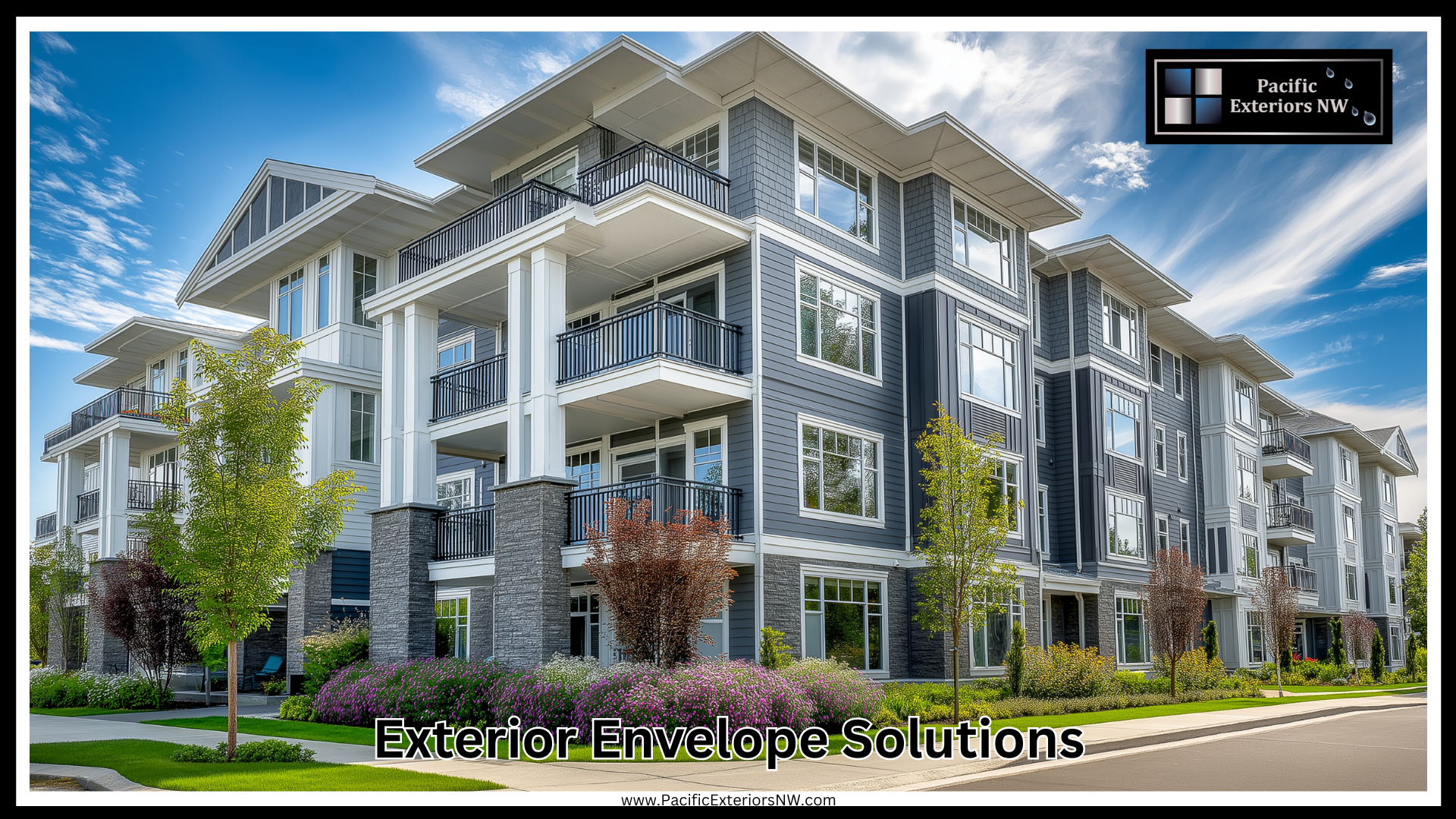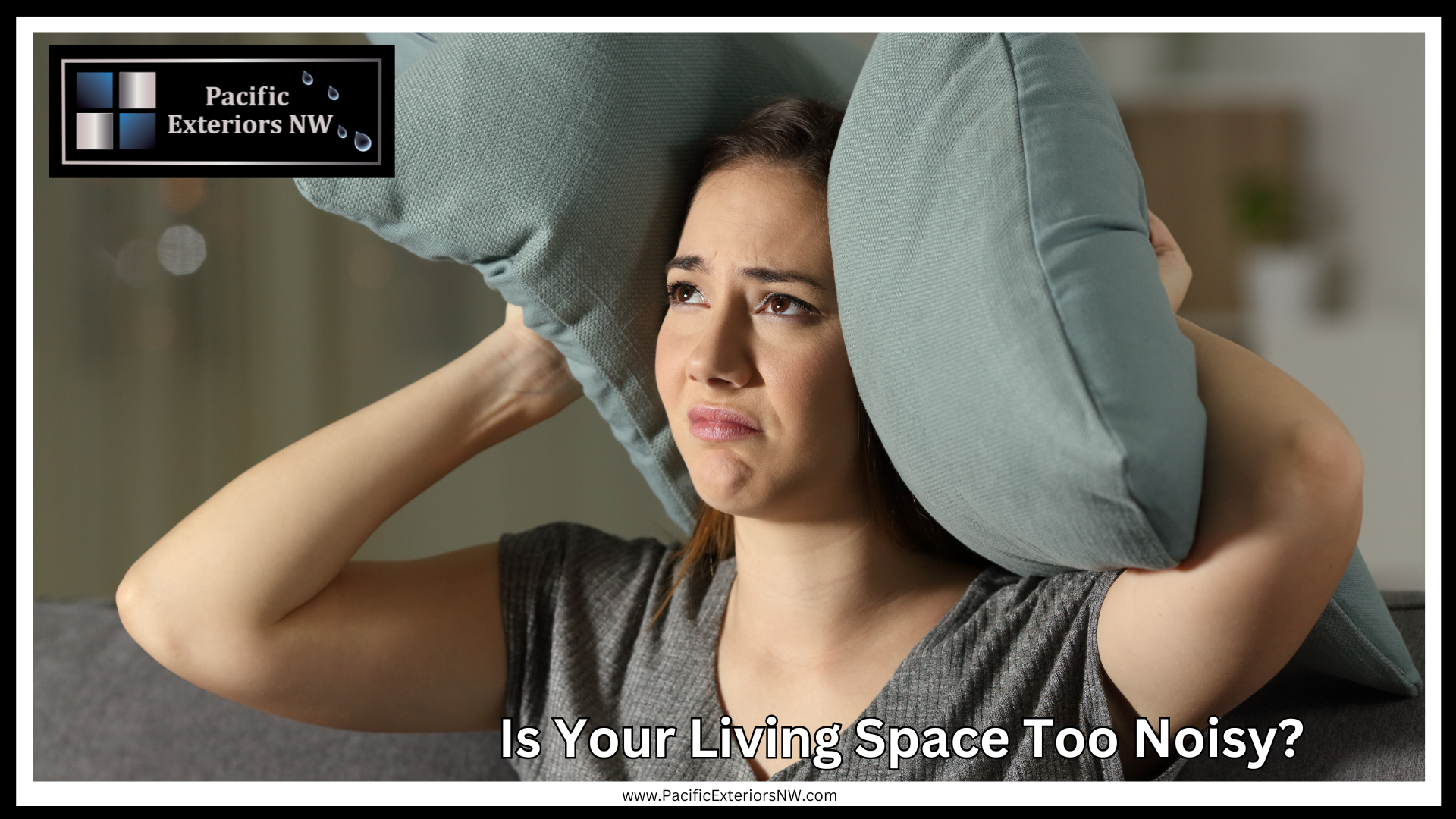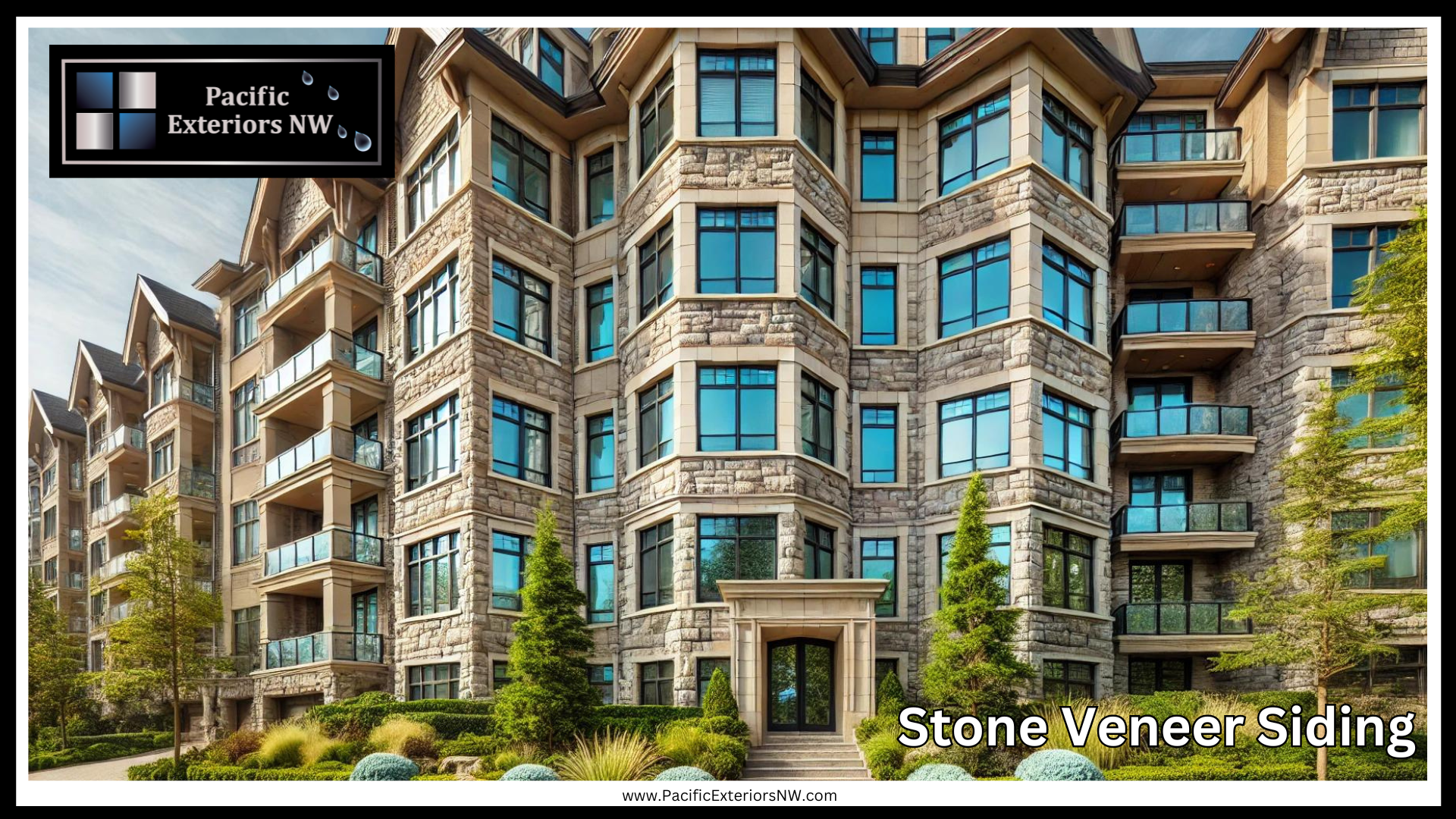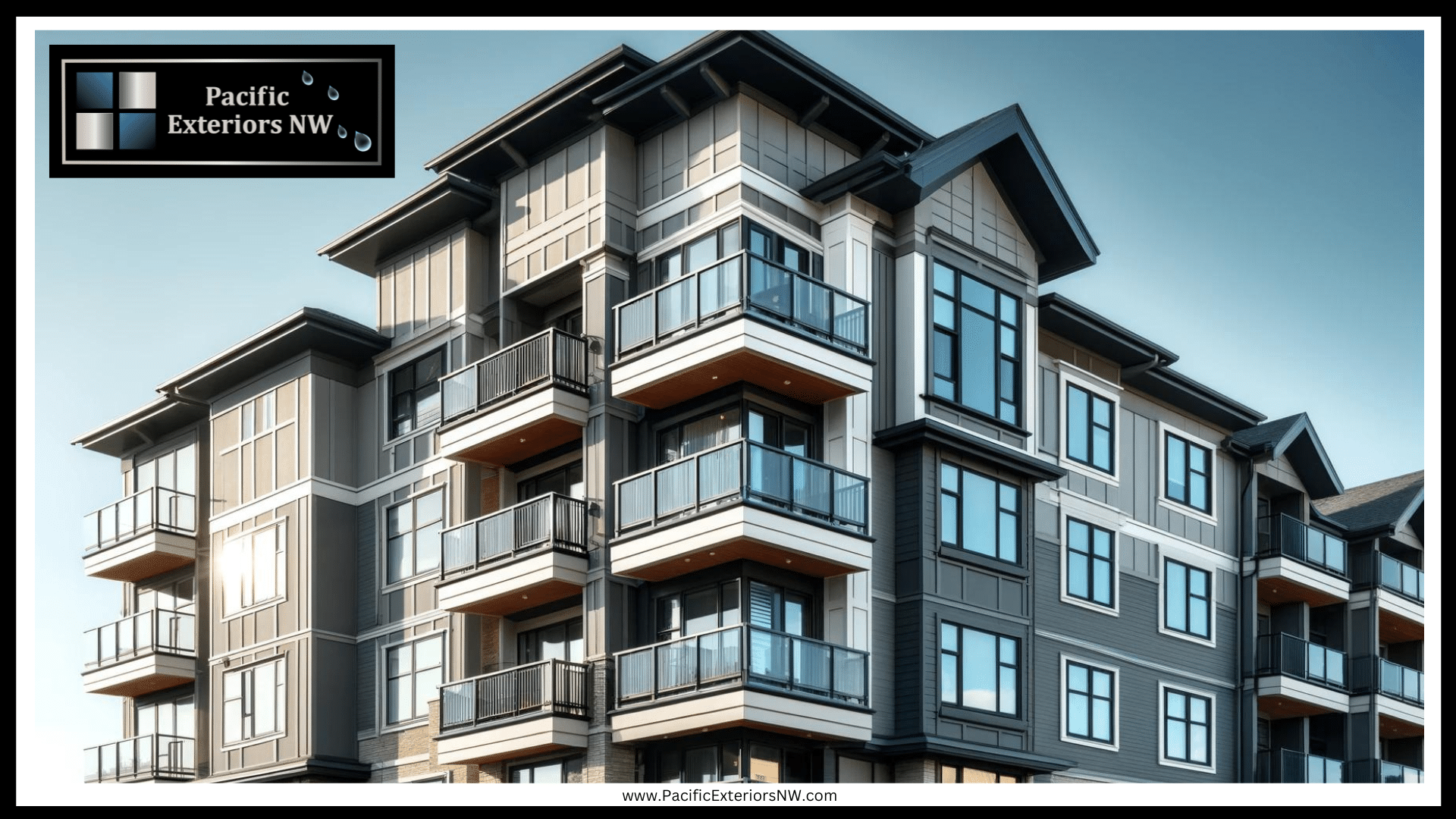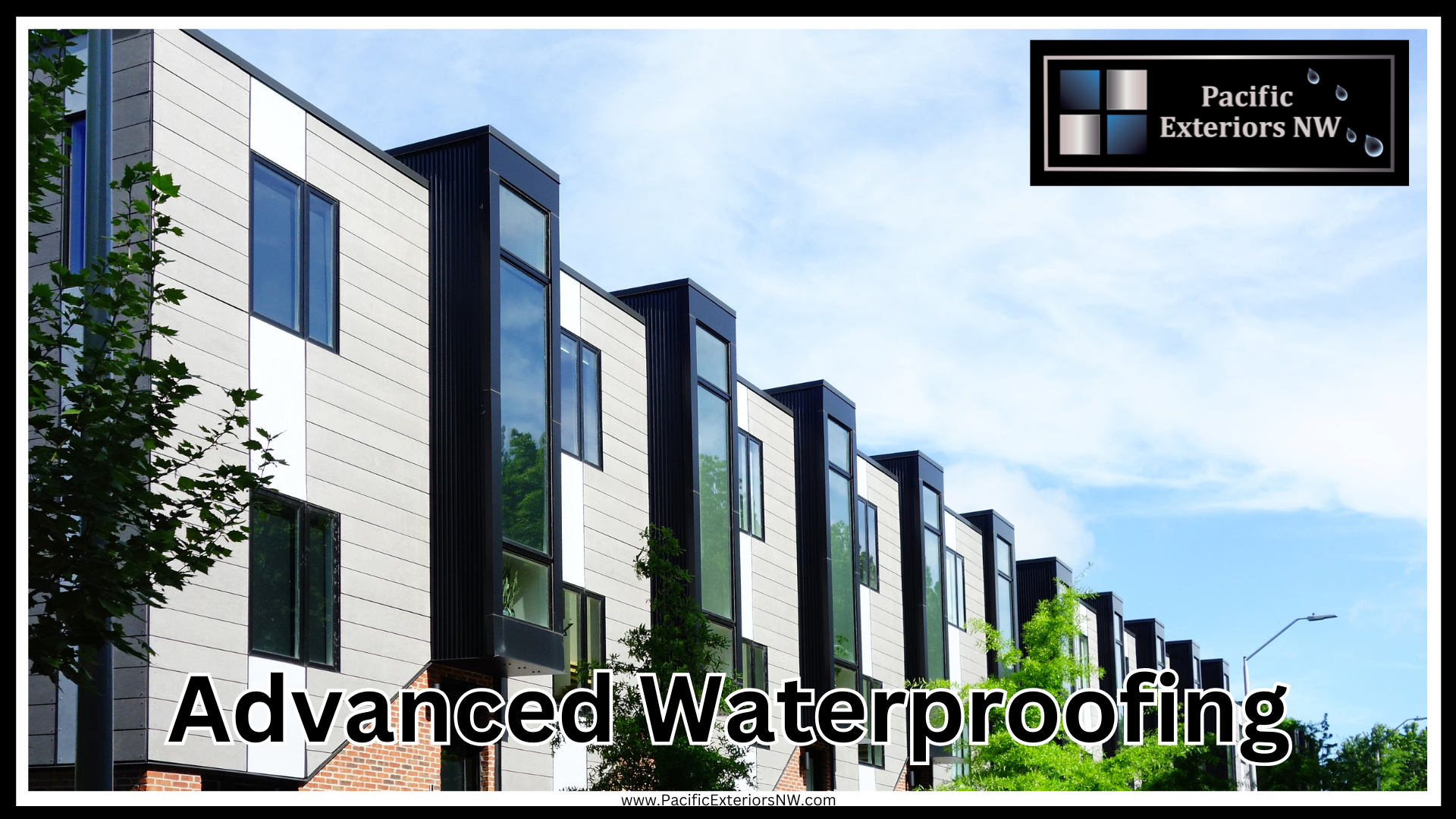
Why is Advanced Waterproofing Important?
Ensuring the safety and longevity of multi-family buildings is paramount for owners and tenants. Water damage remains one of the most insidious threats, capable of causing severe structural issues, mold growth, and costly repairs. This guide explores cutting-edge waterproofing methods, from flexible membranes to drainage mats, tailored for the multi-family housing sector.
Pacific Exteriors NW has spent years perfecting these techniques to protect properties throughout the Pacific Northwest. Let’s explore these game-changing waterproofing solutions and discover which one could be the perfect fit for your next project.
Why Advanced Waterproofing is Crucial for Multi-Family Buildings
Multi-family buildings, like condominiums and apartment complexes, face unique challenges. High occupancy levels increase wear and tear, and exterior surfaces are constantly exposed to the elements. Water intrusion can lead to weakened foundations, hazardous mold growth, and a significantly shortened lifespan for the building.
Common Risks of Water Intrusion
- Foundation Weakening: Water pressure can crack concrete walls.
- Mold and Mildew: Even a small leak can lead to widespread mold issues.
- Increased Maintenance Costs: Water damage repairs are among the costliest.
An eye-opening fact? According to studies, moisture problems are the second most common cause of building damage after structural failures. This illustrates how imperative it is to prioritize proper waterproofing from the outset.
1. Liquid-Applied Membranes
One advanced waterproofing system is liquid-applied membranes are flexible, fluid solutions applied directly to surfaces, curing into a seamless and durable waterproof layer. Made from materials like polyurethane or acrylics, they are highly adaptable and effective for covering complex surfaces.
Where They’re Used:
- Balconies and Decks: Ideal for irregular shapes and areas prone to water pooling.
- Foundations and Basements: Ensures no gaps or seams for water to exploit.
Benefits:
- Seamless Coverage: Reduces weak points where water might penetrate.
- Flexibility: Can expand and contract with building movements.
Pacific Exteriors, NW uses liquid-applied membranes in areas with difficult access or intricate architectural designs, ensuring a watertight seal that lasts.
2. Bentonite Clay Barriers
Bentonite clay waterproofing is a natural and highly effective solution for below-grade waterproofing. This method leverages bentonite clay’s unique, moisture-reactive properties to create a powerful and long-lasting waterproof barrier. As a naturally occurring, volcanic ash-based material, bentonite clay swells significantly when exposed to water. This swelling action forms an impermeable layer, preventing water from passing through and protecting the structure from moisture intrusion.
What Is Bentonite Clay?
Bentonite clay is composed mainly of montmorillonite, a mineral known for its exceptional water-absorption capabilities. When dry, bentonite clay appears as a fine, powdery material. However, it expands to several times its original volume when it comes into contact with water. This property makes it highly effective as a self-sealing, waterproofing material, capable of filling gaps, cracks, and voids.
The material is widely used in construction and environmental engineering applications, such as landfill liners, dam sealing, and foundation waterproofing. It has earned a reputation for being both eco-friendly and incredibly durable.
How Bentonite Clay Waterproofing Works
The waterproofing process using bentonite clay is based on the clay’s ability to expand and seal off water pathways. Here’s a simplified explanation of how it works:
- Initial Installation: Bentonite clay is installed as a compacted layer or in panels (commonly called bentonite sheets) around the foundation or retaining wall. These panels are often sandwiched between two layers of geotextile fabric for added strength and durability.
- Moisture Activation: When groundwater or moisture comes into contact with the bentonite clay, the clay absorbs the water and expands. This expansion creates a dense, gel-like barrier that blocks water from passing through.
- Self-Sealing Properties: If cracks or voids develop in the foundation over time, the bentonite clay will automatically swell to fill these gaps, maintaining its effectiveness as a waterproof barrier.
Types of Bentonite Clay Waterproofing Systems
There are several ways to use bentonite clay in waterproofing applications. The choice of system depends on the specific requirements of the project:
- Bentonite Clay Panels: These are prefabricated sheets or panels made of bentonite clay sandwiched between two layers of geotextile fabric. They are easy to install and are commonly used for below-grade foundation walls and under slabs.
- Sprayed Bentonite Slurry: In this method, a bentonite slurry (a mixture of bentonite clay and water) is sprayed onto the foundation’s surface. The slurry then dries to form a continuous and impermeable barrier.
- Bentonite Matting: This system uses a layer of bentonite clay between two waterproof membranes. It is often used for projects requiring additional durability, such as heavy soil loads or high water tables.
Best Applications for Bentonite Clay Waterproofing
Bentonite clay is an excellent waterproofing material for various applications, particularly subterranean or high-water-pressure environments. Here’s where bentonite clay waterproofing shines:
- Below-Grade Foundations and Basements: One of the most common uses of bentonite clay is for protecting below-grade foundations from groundwater. Whether your building has a basement or is in an area with a high water table, bentonite clay can provide an impermeable seal.
- Retaining Walls and Underground Structures: Retaining walls often face significant soil pressure and moisture exposure. Bentonite clay forms a robust barrier that helps to keep water at bay, preventing seepage and erosion.
- Tunnel and Infrastructure Projects: Bentonite clay is used to construct tunnels and underground transportation systems, where water intrusion can cause serious safety hazards.
- Green Construction Projects: Given its eco-friendly properties, bentonite clay is often the material of choice for projects focused on sustainability. It is non-toxic, does not leach harmful chemicals, and is environmentally safe.
Advantages of Bentonite Clay Waterproofing
Bentonite clay has several advantages that make it a popular choice for waterproofing multi-family and commercial buildings:
- Self-Healing Capabilities: One of the standout features of bentonite clay is its ability to self-heal. If the foundation shifts or cracks over time, the clay will automatically swell and fill any voids, maintaining an uninterrupted barrier against water.
- Eco-Friendly and Sustainable: As a natural material, bentonite clay is environmentally friendly and safe for construction projects. It doesn’t release harmful chemicals into the soil or water, making it an ideal choice for green building practices.
- Long-Lasting Protection: Bentonite clay doesn’t break down or degrade over time, even when exposed to repeated wetting and drying cycles. This ensures long-term protection and peace of mind for building owners.
- High Water Pressure Resistance: Bentonite clay is highly effective in environments where water pressure is a significant concern. Its swelling action creates a dense barrier capable of withstanding extreme conditions.
Challenges and Considerations
While bentonite clay waterproofing has many benefits, there are some considerations to keep in mind:
- Proper Installation Is Critical: The effectiveness of bentonite clay depends on correct installation. If not installed properly, the clay may not fully expand, leaving gaps in the waterproofing barrier. Hiring experienced professionals, like those at Pacific Exteriors NW, is essential for ensuring proper application.
- Soil and Climate Conditions: Bentonite clay works best in environments with consistent moisture exposure. In extremely dry conditions, the clay may not swell adequately, reducing its effectiveness. Additional waterproofing measures may be required in arid climates.
- Limited Above-Grade Use: Bentonite clay is primarily used for below-grade applications. It is unsuitable for above-ground waterproofing, as its performance relies on soil pressure to maintain contact with the surface.
Installation Process
Installing bentonite clay panels or mats involves precise steps to ensure optimal performance. Here’s how Pacific Exteriors NW approaches a typical installation:
- Site Preparation: The foundation wall or surface is cleaned and prepared to ensure proper adhesion. Any debris or loose material is removed, and the surface is leveled.
- Panel Placement: To prevent gaps, Bentonite panels or mats are laid out in an overlapping pattern. The seams between panels are carefully sealed to create a continuous barrier. Mechanical fasteners or adhesives are sometimes used to secure the panels in place.
- Backfilling: Once the panels are in place, the area is backfilled with soil. The soil pressure helps keep the bentonite panels pressed against the foundation, ensuring a tight seal. As groundwater comes into contact with the bentonite, the clay will swell and create a watertight barrier.
- Quality Control: After installation, a thorough inspection ensures that all panels are properly aligned and secured. Any potential weak spots are addressed before the project is completed.
Real-World Example from Pacific Exteriors NW
Pacific Exteriors NW has successfully used bentonite clay waterproofing in various challenging environments. For instance, we relied on bentonite clay panels to protect the building’s foundation in a recent multi-family residential project built on a hillside with high groundwater pressure. The clay’s self-sealing properties proved invaluable, providing peace of mind to the property owners and safeguarding the structure from potential water damage.
Here’s an interesting tidbit—bentonite clay isn’t just used for waterproofing. It’s also a staple in the cosmetics industry, where it’s prized for its skin-detoxifying properties. People use bentonite clay masks to draw out impurities and toxins from their skin, much like how the clay acts as a protective shield against water in construction!
Why Choose Bentonite Clay for Your Project?
Bentonite clay waterproofing is a smart, sustainable choice for below-grade applications. It offers unmatched self-sealing capabilities and long-term reliability. At Pacific Exteriors NW, we have extensive experience working with this material and can customize a waterproofing plan that suits your building’s unique needs.
Whether you’re dealing with high water tables and soil pressure or simply want a green, eco-friendly option, bentonite clay is a tried-and-true solution you can trust.
3. Sheet Membranes
Sheet membranes are prefabricated waterproofing sheets, often made from rubberized asphalt or high-density polyethylene. They are laid down and adhered to surfaces, providing a consistent waterproof barrier.
Best Use Cases:
- Basement Walls: Ensures even, reliable protection.
- Green Roofs: Excellent for rooftops designed to hold vegetation and soil.
Pros and Cons:
- Pros: Uniform thickness ensures reliable coverage. It is faster to install on large surfaces.
- Cons: Requires meticulous seam sealing to prevent leaks.
Pacific Exteriors NW recommends sheet membranes for projects needing speed without compromising waterproofing quality.
4. Cementitious Waterproofing
Cementitious waterproofing products are cement-based and used primarily on concrete or masonry surfaces. They’re known for their durability and ease of application.
Ideal Applications:
- Water Tanks and Swimming Pools: Suitable for structures constantly exposed to water.
- Foundation Walls and Elevator Pits: Handles constant pressure from surrounding soil.
Features:
- Ease of Use: Simple to mix and apply with a trowel or brush.
- Durability: Resistant to chemical exposure and extreme conditions.
However, cementitious systems may require additional protective coatings in areas subject to continuous movement or high moisture.
5. Elastomeric Coatings
Elastomeric coatings are rubber-like, flexible coatings applied to exterior walls. They can stretch and recover, making them suitable for buildings that experience structural movement.
Where They Excel:
- Exterior Walls: Protects against wind-driven rain and minor wall cracks.
- Older Buildings: Perfect for rehabilitating aging facades.
Key Benefits:
- High Elasticity: Moves with the building without cracking.
- UV Resistance: Protects surfaces from the sun’s damaging rays.
Pacific Exteriors NW often uses elastomeric coatings to revitalize old brick and stucco walls, adding a modern touch while extending their lifespan.
6. Negative-Side Waterproofing
Negative-side waterproofing involves applying waterproofing materials to the interior side of a structure to block water from the outside. It’s especially helpful when exterior access isn’t an option.
Typical Uses:
- Basement Retrofits: Prevents water from entering already-built underground spaces.
- Historic Renovations: Preserves the exterior appearance while reinforcing the interior.
Benefits:
- Cost-Effective for Retrofitting: No need to excavate or disrupt the landscape.
- Versatile Applications: Effective even under high water pressure.
Negative-side waterproofing has been used to restore centuries-old European castles to keep them dry!
7. Integral Waterproofing Additives
Integral waterproofing involves mixing additives directly into the concrete when pouring. These additives make the concrete itself water-resistant by filling its pores.
Best For:
- Basement Floors and Walls: Ideal for new construction.
- Water Reservoirs: Perfect for structures that must retain or exclude water.
Advantages:
- Long-Lasting Protection: No need for re-application.
- Deep Penetration: Protects even if the surface wears away.
Pacific Exteriors, NW incorporates these additives in projects needing rock-solid, long-term moisture resistance from the ground up.
8. Hot Rubberized Asphalt Systems
Hot rubberized asphalt is a fluid-applied membrane that cures to form a strong, fully adhered waterproof barrier. It’s extremely durable and used in high-stress environments.
Applications:
- Plaza Decks: Supports heavy foot traffic and landscaping.
- Green Roofs: Prevents root penetration and water damage.
Features:
- Seamless Barrier: No weak points for water to exploit.
- Thermal Stability: Withstands extreme temperatures and building movement.
9. Cold-Applied Liquid Waterproofing
Cold-applied waterproofing systems are a modern and convenient approach to protecting buildings from water damage. Unlike hot-applied methods, which require heating materials to high temperatures, cold-applied systems can be used straight out of the container. This makes them safer, more versatile, and ideal for projects where heat is impractical or risky.
These systems are generally liquid-based and are applied at ambient temperatures, forming a durable, seamless, and flexible barrier that effectively blocks moisture. Cold-applied waterproofing options are gaining popularity in multi-family construction projects for their ease of use, cost-effectiveness, and adaptability to various surfaces and conditions.
What Are Cold-Applied Waterproofing Systems?
Cold-applied waterproofing products typically consist of solvent-based or water-based liquid membranes. They are formulated to cure and create a seamless layer that bonds tightly to various substrates, such as concrete, metal, wood, and masonry. The result is a highly flexible, robust, and waterproof coating that can withstand movement and weather-related stress without cracking.
There are several types of cold-applied waterproofing systems, including:
- Single-Component Liquid Membranes: Ready-to-use products that require no mixing. They are perfect for small to medium-sized projects or for repairs.
- Two-Component Systems: These systems require the mixing of a base and a curing agent. They provide higher performance and are ideal for larger or high-stress applications.
- Elastomeric Cold-Applied Coatings: Made from rubber-like polymers, these coatings provide superior elasticity and are perfect for areas prone to thermal expansion and contraction.
How Cold-Applied Waterproofing Works
Cold-applied waterproofing materials are typically spread, rolled, or sprayed onto the substrate in one or more layers. As the liquid cures, it bonds tightly to the surface, forming a continuous, flexible, and impermeable membrane. The curing process can be accelerated or slowed based on environmental conditions, such as temperature and humidity, allowing for some control over application speed.
Key Benefits of Cold-Applied Waterproofing
Cold-applied waterproofing systems have a range of advantages, making them an excellent choice for multi-family buildings:
- Safe and Easy Application: Since these systems don’t require heating, they eliminate the risks associated with hot-applied waterproofing, such as burns or fire hazards. This makes them ideal for use in confined or occupied spaces, where safety is a top priority.
- Seamless Coverage: Cold-applied systems form a continuous, seamless barrier like hot-applied membranes. This reduces the risk of water infiltrating through joints or seams, common weak points in traditional waterproofing methods.
- Highly Flexible: Cold-applied membranes are designed to accommodate a building’s natural movement. They can expand and contract with temperature fluctuations, ensuring long-lasting protection without cracking.
- Fast and Efficient Installation: Cold-applied waterproofing can be applied quickly, reducing labor costs and minimizing project delays. This efficiency is crucial in fast-paced construction environments, especially for multi-family developments.
- Low Odor and Low VOC Options: Many cold-applied systems are formulated with low volatile organic compounds (VOCs), making them environmentally friendly and safe for indoor or sensitive areas. This feature is particularly important for multi-family buildings, where strong odors could disrupt or endanger residents.
Common Applications for Cold-Applied Waterproofing
Cold-applied waterproofing systems are versatile and can be used in various settings throughout multi-family buildings. Here’s where they’re most effective:
- Foundations and Basement Walls: Cold-applied membranes are often used to waterproof below-grade foundation walls, protecting basements from groundwater seepage. Their strong adhesion and flexibility make them ideal for these critical areas.
- Parking Decks and Podiums: Multi-family buildings often have parking decks or podium slabs exposed to harsh weather and constant vehicular traffic. Cold-applied waterproofing provides a durable, non-slip barrier that removes water and resists wear and tear.
- Balconies and Terraces: Outdoor living spaces like balconies and terraces require robust waterproofing to withstand foot traffic, heavy rain, and freeze-thaw cycles. Cold-applied systems create a weather-resistant surface that withstands the elements.
- Interior Wet Areas: Cold-applied waterproofing can also be used indoors, in places like bathrooms, kitchens, or utility rooms where water resistance is essential. Because these products are often low in odor, they’re safe for use in occupied buildings without disturbing residents.
- Roofing Applications: Some cold-applied membranes are suitable for flat or low-slope roofs, providing a flexible, UV-resistant barrier that prevents leaks and extends the roof’s lifespan.
Installation Process
Applying cold-applied waterproofing may seem straightforward, but it requires careful attention to detail to ensure the best results. Here’s a general overview of the process:
- Surface Preparation: Proper substrate preparation is crucial for adhesion. The surface must be clean, dry, and free of dust, oil, and other contaminants. Sometimes, a primer may be applied to improve the membrane and surface bond.
- Application of the Membrane: The cold-applied liquid membrane is spread, rolled, or sprayed onto the surface in even layers. Multiple coats may be required to achieve the desired thickness, depending on the product. Additional reinforcing fabric may be embedded in the membrane for extra durability for areas prone to high stress.
- Curing Time: The process depends on the specific product and environmental conditions. While some membranes cure quickly, others may take longer in colder or more humid climates. It’s important to follow the manufacturer’s instructions to ensure proper curing and optimal performance.
- Quality Control and Inspection: After curing, the membrane is inspected for imperfections, such as thin spots or areas where the coating may have pulled away from the substrate. Any necessary touch-ups are made to ensure a fully watertight seal.
Why Pacific Exteriors NW Prefers Cold-Applied Waterproofing
At Pacific Exteriors NW, we choose cold-applied waterproofing systems for many projects due to their unmatched versatility and safety. We’ve used these systems to waterproof everything from underground parking garages to high-traffic rooftop decks, with impressive results. Our team has seen firsthand how cold-applied waterproofing can simplify complex projects and deliver long-lasting protection, all while keeping our crew and building occupants safe.
Real-World Example from Pacific Exteriors NW
In a recent multi-family project in a busy urban area, our team faced a unique challenge: waterproofing a series of below-grade basement walls without disturbing the residents. Using a cold-applied waterproofing system, we could complete the job efficiently without the hazards associated with hot-applied methods. The product’s low odor and quick-curing properties minimized disruption to the residents, while the seamless membrane provided excellent protection against groundwater intrusion.
A Surprising Fact!
Here’s a little-known fact: Cold-applied waterproofing technology has roots in the automotive industry! Many of the same flexible, durable, and weather-resistant materials were initially developed to protect car undercarriages from water and corrosion. This cross-industry innovation shows how reliable and tested these materials are when used in building construction.
Environmental and Sustainability Considerations
Cold-applied waterproofing systems often feature eco-friendly formulas that are free of hazardous chemicals. Products with low VOCs help reduce indoor air pollution and comply with strict environmental regulations. This makes them an excellent choice for projects aiming for LEED certification or those prioritizing sustainability.
Key Considerations for Cold-Applied Waterproofing
While cold-applied systems offer many benefits, there are some factors to keep in mind:
- Weather Sensitivity: Cold-applied membranes generally perform best in moderate temperatures. Extremely cold or damp weather can slow the curing process and impact adhesion, so scheduling applications during favorable weather conditions is essential.
- Surface Condition: A well-prepared substrate is critical for successful application. Surfaces that are uneven, wet, or contaminated can compromise the membrane’s ability to bond effectively, leading to potential leaks.
- Limited Load Resistance: While cold-applied membranes are flexible and durable, they may not be the best choice for areas that experience extreme mechanical loads or heavy, repetitive impact. In such cases, a more rigid waterproofing system may be required.
Cold-applied waterproofing options provide a safe, efficient, and flexible way to protect multi-family buildings from water damage. They’re perfect for various applications, from below-grade foundations to balconies and interior wet rooms. At Pacific Exteriors NW, our expertise in these systems ensures that your building receives top-notch waterproofing tailored to your specific needs.
10. Self-Adhering Membranes
These membranes come with a peel-and-stick backing, allowing for simple installation. They’re best for smaller or more confined spaces.
Use Cases:
- Roofing Systems: Great for flashing and around HVAC units.
- Foundation Walls: Quick to install on vertical surfaces.
Perks:
- User-Friendly: Easy to apply even for less experienced crews.
- Superior Adhesion: Bonds well to most building materials.
11. Drainage Mat Systems
Drainage mats channel water away from the structure, preventing the buildup of hydrostatic pressure against walls. They work hand-in-hand with waterproofing membranes to boost effectiveness.
Ideal Situations:
- Below-Grade Applications: Keeps water moving away from basements.
- Green Roofs: Aids in water management and root barrier protection.
Example: Pacific Exteriors, NW often pairs drainage mats with bentonite clay barriers for a comprehensive waterproofing system in underground installations.
The design of modern drainage mats was inspired by ancient aqueducts that channeled water through complex Roman cities.
Selecting the right waterproofing system for your multi-family building can mean the difference between a structurally sound property and a costly disaster. Pacific Exteriors, NW stands ready to implement these advanced solutions, ensuring your investment remains safe and dry for years to come.
FAQs for Advanced Waterproofing
What is the most effective waterproofing system for multi-family buildings?
The best system depends on your specific needs. Liquid-applied membranes and integral additives are generally reliable and flexible.
How often should waterproofing be inspected?
Annual inspections are recommended to catch minor issues before they turn into costly repairs.
Can different waterproofing methods be combined?
Yes, and it’s often encouraged. For example, using sheet membranes alongside drainage mats offers added protection.
Would you like to explore these waterproofing options further for your next project? Contact Pacific Exteriors NW for a detailed consultation and to learn how we can help protect your building from water damage.




